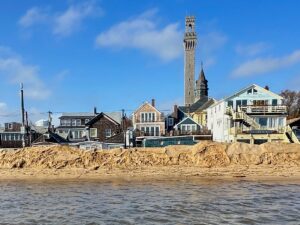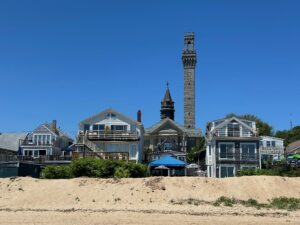PROVINCETOWN — Ever since a powerful storm on Jan. 4, 2018 sent seawater coursing over Ryder Street Beach and down Gosnold Street, flooding numerous homes and businesses near town hall, it has been a priority of town government to build a seven-foot-high dune on the shore to block that flood pathway.

In April 2018, town meeting voters approved $200,000 to help secure grants and initial designs for the dune project, and in September 2020, voters OKed another $200,000 to help pay for easements the town might need.
Almost five years later, however, the dune is still far from being built. The town has yet to purchase or acquire any easements from neighboring property owners because its attorneys and state officials do not agree on whether the easements are needed.
The Dept. of Public Works has installed a four-foot-tall sand berm on the beach every winter since 2018 — and that berm appeared to prevent flooding in the neighborhood on Jan. 13, 2024.
But the permanent dune cannot be built without a key license from state regulators, who maintain that either easements or written permission from landowners are required before the project can begin.
Chapter 91
The years of delay are primarily because of the complexity of the state’s Chapter 91, which ensures public access to the intertidal zone, according to Provincetown Community Development Director Tim Famulare and DPW Director Jim Vincent.
That law, with precedents dating back to the colonial era, protects the public’s right to access privately owned intertidal areas for “fishing, fowling, and navigation.”
Provincetown has its own unusual colonial history, however, as land that was held in common for the whole Province of Massachusetts Bay. The town’s 1727 charter did not give it the right to grant land to individual settlers — which is why the Province Lands were still held by the state as late as 1961.
Another effect of that charter is that the town has never been able to grant waterfront property owners control of the intertidal zone adjacent to their property — so the part of the beach that is covered by tides, all the way from the Provincetown Inn to Howland Street, is publicly owned.
Because of the way Chapter 91 is written, the public’s rights to Provincetown’s tidelands actually extend all the way up to the historic high water lines of 1848 and 1939 — with the line that cuts deeper into current land at any given spot being the controlling one, according to Vincent, who was formerly the assistant director of the state Dept. of Environmental Protection’s Waterways Program, the agency that implements the law.
Town maps show the 1848 historic high water line bisecting structures such as Whalers Wharf and the Crown & Anchor and continuing to cut just behind or through seven more buildings that back up against Ryder Street Beach, including the Julie Heller Gallery, George’s Pizza, and Café Maria.
The 1848 high water line takes a rectangular jog out onto Ryder Street Beach behind an eighth structure, where the restaurant Tin Pan Alley is located, because a wharf or filled pier used to exist there, Vincent said.
“The whole beach that you can see at Gosnold and Ryder is this area of overlapping rights,” Famulare told the Independent in 2019, when the town was first evaluating the problem of easements for the dune.
The DEP is supposed to write individual Chapter 91 licenses for each property where private buildings exist — or want to expand — on land where the public also has tideland claims.
Only two of the properties where the dune would be built have Chapter 91 licenses, however.
A Legal Thicket
The town’s outside appraisers and counsel agreed in 2020 that it should need only to secure an easement for the land behind Tin Pan Alley, Famulare said — which is why the September 2020 article funding the easements was amended on the floor of town meeting to remove most of the nine parcels near the dune project.

“It was the research of the appraisers that said, ‘We think you don’t need easements here; we think you have the right’ ” to build on most of Ryder Street Beach, Famulare said.
After the vote, however, the town’s appraisers and lawyers did not agree on how to move forward with “taking” that easement through eminent domain, Famulare said. The easement would have been for the town’s right to build and maintain a coastal defense structure on the land but would not have actually taken any land.
“There was some back and forth between them, and it took some time, and part of it was the complexity of the Commonwealth Tidelands,” Famulare said. The issue was not so much the amount of compensation but having legal justification for it “sufficient to hold up in court,” he said.
When town officials later learned that the 1939 historic high water map could also be used in Chapter 91 cases, the issue appeared to be resolved — the wharf or pier behind 269 Commercial St. had been destroyed by 1939, and the whole area where the dune would need to be built was in public tidelands on that map.
It is now the position of the town’s lawyers that no easements are needed because the underlying land is Commonwealth tidelands, according to Vincent and Famulare.
Town officials called a meeting with state officials last December to revive the town’s Chapter 91 license application for the dune project — but at that meeting, the DEP officials said the town still needs to have the signatures of property owners or other evidence of legal authority to start work at the site.
Famulare and the town’s Director of Sustainability and Resilience Melyssa Nickerson asked the state for case law to back up that interpretation in December and again in February, according to emails provided in response to a records request from the Independent — but the state has still not provided those citations, Famulare said.
In response to questions from the Independent, a spokesperson for the DEP wrote that the agency “does not have the authority to decide property rights” and “cannot provide legal guidance to the town.”
The agency “remains committed to working with the Town of Provincetown to ensure the Gosnold Dune flood protection project complies with Chapter 91,” the spokesperson wrote.
“Until we get their legal counsel communicating directly with our legal counsel, and we get two lawyers in a room, I don’t think we’re going to resolve this,” Vincent said.
Provincetown’s unusual tidelands have been “little understood, even by current DEP staff,” said Famulare. “We have other projects we want to undertake, so it’s important to get to the bottom of this.”
